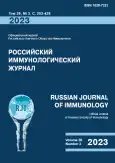Роль пассивной и активной миостимуляции в изменении уровней некоторых цитокинов
- Авторы: Ахметьянов Р.Р.1, Давыдова Е.В.1,2, Сабирьянов А.Р.2, Щербакова И.Л.1
-
Учреждения:
- ГБУЗ «Челябинская областная клиническая больница»
- ФГБОУ ВО «Южно-Уральский государственный медицинский университет» Министерства здравоохранения РФ
- Выпуск: Том 26, № 3 (2023)
- Страницы: 211-216
- Раздел: КРАТКИЕ СООБЩЕНИЯ
- URL: https://journals.rcsi.science/1028-7221/article/view/253394
- DOI: https://doi.org/10.46235/1028-7221-9907-ROP
- ID: 253394
Цитировать
Полный текст
Аннотация
Травма передней крестообразной связки (ПКС) коленного сустава сопровождается развитием артрогенного мышечного торможения, вследствие дизрегулирующих афферентных влияний на возбудимость спинномозговых и супраспинальных путей. Цель – изучение показателей электромиографии, уровней миокинов на фоне миостимуляции при травматическом повреждении ПКС.
Принимали участие 28 мужчин-спортсменов с травматическим повреждением ПКС. Все пациенты при поступлении проходили электромиографическое исследование травмированной конечности на аппарате ЭМГ/ВП Viking Quest (Nicolet, США). Части пациентов за 10 дней до начала оперативного лечения, проводили пассивную электромиостимуляцию (ЭМС) четырехглавой мышцы бедра на аппарате INTELECT® Advanced (Chattanooga (DJO), США). Далее всем пациентам проводили артропластику на артроскопе Karl Storz (Германия). В послеоперационный период на протяжении 2-недельной иммобилизации все пациенты получали ЭМС, после снятия ортеза пациенты переходили к режиму активных тренировок. Уровни цитокина IL-6 исследовали с помощью набора реагентов для ИФА (АО «Вектор-Бест», Новосибирск), трансформирующего фактора роста – β (Cloud-Clone Corp., Китай). Статистическая обработка материала проводилась при помощи пакета Statistica. vers.10.0 (StatSoft Inc., США).
Наиболее высокая средняя амплитуда (мкВ) при проведении электромиографии регистрировалась у здоровых лиц, у пациентов основной группы фиксировались значимо меньшие величины средней амплитуды. После проведения 10-дневной ЭМС отмечено значимое увеличение показателя до значений здоровых лиц. В динамике после оперативного вмешательства показатели ЭМГ без ЭМС оставались на прежнем низком уровне, значения, регистрируемые на фоне ЭМС, были сравнимы со здоровыми лицами, что отражает более быстрое и качественное восстановление мышц после травмы. Уровни цитокинов – миокинов IL-6 и TGF-β1 значимо превысили исходные уровни на фоне ЭМС. Биологическое значение повышения уровня IL-6 при мышечной нагрузке заключается в активации на уровне скелетной мускулатуры АМФ-киназы и/или фосфатидилинозитол-3-киназы и более эффективном обеспечении мышц энергетическим субстратом. TGF-β1 способствует пролиферации фибробластов, увеличивает содержание коллагена.
Проведение пассивной и активной ЭМС приводит к улучшению показателей электромиографии, повышению концентрации в крови миокинов – IL-6 и TGF-β1, что способствует улучшению энергетического баланса, повышению противовоспалительного и репаративного потенциала поврежденных тканей.
Ключевые слова
Полный текст
Открыть статью на сайте журналаОб авторах
Рустам Рафисович Ахметьянов
ГБУЗ «Челябинская областная клиническая больница»
Email: dr.ahm345@gmail.com
врач травматолог-ортопед отделения травматологии и ортопедии
Россия, 454048, Челябинск, ул. Воровского, 70Евгения Валерьевна Давыдова
ГБУЗ «Челябинская областная клиническая больница»; ФГБОУ ВО «Южно-Уральский государственный медицинский университет» Министерства здравоохранения РФ
Автор, ответственный за переписку.
Email: davidova-ev.med@yandex.ru
доктор медицинских наук, доцент, профессор кафедры, заведующий отделением ранней медицинской реабилитации
Россия, 454048, Челябинск, ул. Воровского, 70; Челябинск ул. Воровского, 64Артур Раисович Сабирьянов
ФГБОУ ВО «Южно-Уральский государственный медицинский университет» Министерства здравоохранения РФ
Email: Lfksar@mail.ru
доктор медицинских наук, профессор, заведующий кафедрой медицинской реабилитации и спортивной медицины
Россия, Челябинск, ул. Воровского, 64Ирина Львовна Щербакова
ГБУЗ «Челябинская областная клиническая больница»
Email: ii_ri_na@mail.ru
заведующий отделением нейрофизиологии
Россия, 454048, Челябинск, ул. Воровского, 70Список литературы
- Васюкова О.В., Касьянова Ю.В., Окороков П.Л., Безлепкина О.Б. Миокины и адипомиокины: медиаторы воспаления или уникальные молекулы таргетной терапии ожирения? // Проблемы эндокринологии, 2021. Т. 67, № 4. С. 36-45. [Vasyukova O.V., Kasyanova Yu.V., Okorokov P.L., Bezlepkina O.B. Myokines and adipomyokines: inflammatory mediators or unique molecules of targeted therapy for obesity? Problemy endokrinologii = Problems of Endocrinology, 2021, Vol. 67, no. 4, pp. 36-45. (In Russ.)]
- Москалев А.В., Рудой А.С., Апчел А.В., Зуева В.О., Казымова О.Э. Особенности биологии трансформирующего ростового фактора β и иммунопатология // Вестник Российской Военно-медицинской академии, 2016. Т. 2, № 54. С. 206-216. [Moskalev A.V., Rudoy A.S., Apchel A.V., Zueva V.O., Kazymova O.E. Features of the biology of transforming growth factor β and immunopathology. Vestnik Rossiyskoy Voenno-meditsinskoy akademii = Bulletin of the Russian Military Medical Academy, 2016, Vol. 2, no. 54, pp. 206-216. (In Russ.)]
- Anastasieva E., Simagaev R., Kirilova I. Topical issues of surgical treatment of injuries of the anterior cruciate ligament (literature review). Orthopedic Genius, 2020, Vol. 26, no. 1, pp. 117-128.
- Bugera E.M., Duhamel T.A., Peeler J.D., Cornish S.M. The systemic myokine response of decorin, interleukin-6 (IL-6) and interleukin-15 (IL-15) to an acute bout of blood flow restricted exercise. Eur. J. Appl. Physiol., 2018, Vol. 118, no. 12, pp. 2679-2686.
- Filgueira T.O., Carvalho P.R.C., de Sousa Fernandes M.S., Castoldi A., Teixeira A.M., de Albuquerque R.B., de Lima-Filho J.L., Souto F.O. The impact of supervised physical exercise on chemokines and cytokines in recovered COVID-19 patients. Front. Immunol., 2023, Vol. 4, no. 13, 1051059. doi: 10.3389/fimmu.2022.1051059.
- Gomarasca M., Banfi G., Lombardi G. Myokines: The endocrine coupling of skeletal muscle and bone. Adv. Clin. Chem., 2020, Vol. 94, pp. 155-218.
- Hootman J.M., Dick R., Agel J. Epidemiology of collegiate injuries for 15 sports: summary and recommendations for injury prevention initiatives. J. Athl. Train., 2017, Vol. 42, no. 2, pp. 311-319.
- Lepley A.S., Lepley L.K. Mechanisms of arthrogenic muscle inhibition. J. Sport Rehabil., 2021, Vol. 31, no. 6, pp. 707-716.
- Norte G., Rush J., Sherman D. Arthrogenic muscle inhibition: best evidence, mechanisms, and theory for treating the unseen in clinical rehabilitation. J. Sport Rehabil., 2021, Vol. 31, no. 6, pp. 717-735.
- Pietrosimone B., Lepley A.S., Kuenze C., Harkey M.S., Hart J.M., Blackburn J.T., Norte G. Arthrogenic muscle inhibition following anterior cruciate ligament injury. J. Sport Rehabil., 2022, Vol. 31, no. 6, pp. 694-706.
- Sonnery-Cottet B., Saithna A., Quelard B., Daggett M., Borade A., Ouanezar H., Thaunat M., Blakeney W.G. Arthrogenic muscle inhibition after ACL reconstruction: a scoping review of the efficacy of interventions. J Sports Med., 2019, Vol. 53, no. 5, pp. 289-298.
- Vermeijden H.D., Cerniglia B., Mintz D.N., Rademakers M.V., Kerkhoffs G.M.M.J., van der List J.P., diFelice G.S. Distal remnant length can be measured reliably and predicts primary repair of proximal anterior cruciate ligament tears. Knee Surg. Sports Traumatol. Arthrosc., 2021, Vol. 29, pp. 2967-2975.
Дополнительные файлы










